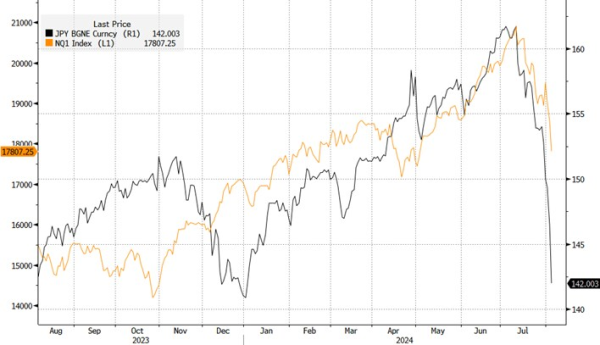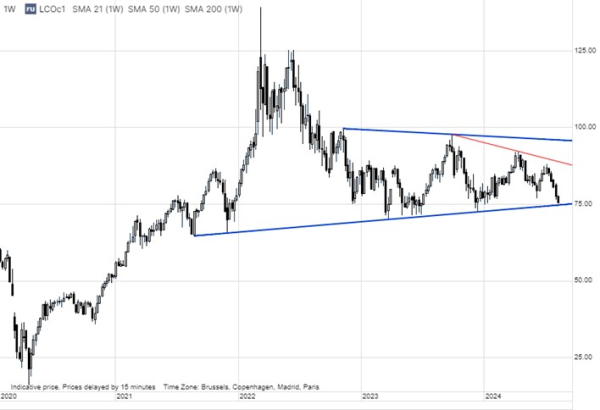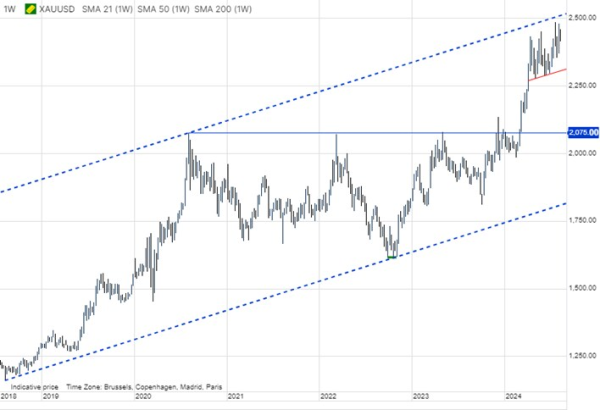Commodities: Position reduction in focus as volatility spikes and US growth slows
Key points
- The current turmoil in global financial markets has reached a level not seen since 2020
- Risk appetite has tumbled after the BoJ rate hike forced traders to exit positions funded by cheap JPY
- In commodities, we are currently seeing growth-dependent sectors from energy to industrial metals suffer
- Gold remains the go-to metal amid the current turmoil and the prospect for accelerated rate cuts in the coming months
The current turmoil in global financial markets has reached a level not seen since 2020, and while a succession of weak US data prints throughout July helped create nervous market conditions with in-demand equity sectors suffering reversals, it was the surprise rate hike from the Bank of Japan on 31 July which triggered what can best be described as a current momentum crash. In addition, last week's weak US data and dovish FOMC message has significantly changed the market sentiment with traders now seeing a major risk the Fed and other central banks are repeating the errors of history by waiting too long to cut interest rates, and then being too slow when they finally start. As a result, the market is now pricing in five 25 bps cut by the FOMC before yearend and a 50 bps cut at the September meeting.
In response to a sharply stronger JPY, big reversals in the stock market and surging bonds, my colleague wrote the following in our daily Global Market Quick: “Sentiment has dramatically changed in just one month. We have gone from high confidence, a record equity index concentration and almost no rate cuts expected in the US, to a market that is now pricing in five rate cuts by year-end in the US and equity markets tumbling in Japan. The short-term outlook is right now driven by risk management policies kicking into gear across many institutional investors. When CVaR (conditional value at risk – key risk measure used in portfolio management) measures increase significantly, funds must cut exposure. Adding to the overall moves are factors such as AI profit-taking, stronger JPY (making funding more expensive), and the equity market index concentration which was the highest in 90 years just three weeks ago. The medium-term outlook will be determined by incoming macro figures. We remain cautiously optimistic about the economy and still think the recession probability is not higher than 33% at this point. There are still many high-frequency macro indicators that are not aligned with the narrative of the economy plunging into a recession.”

The mentioned and ongoing deleveraging of positions has so far seen the Nasdaq 100 briefly touch a three-month low and the Japanese Nikkei a nine-month low, while the yield on US two-year notes has slumped to 3.8% with the market now pricing in five 25 basis-point US rate cuts this year. As mentioned, one of the biggest factors determining the position size an investor is allowed to carry according to preset investment rules, is the prevailing level of volatility. In just three weeks, we have seen the CBOE VIX, a gauge that tracks the volatility of the underlying stocks in the S&P 500 index, surge from a six-year low near to 10% to a four-year high above 40% earlier today. A change of this magnitude has driven the mentioned momentum crash, in the process potentially driving stocks, bonds, and commodities to levels that may not necessarily be supported by fundamentals, and which eventually will reset once the dust settles.
In commodities, we are currently seeing growth-dependent commodities from energy to industrial metals suffer a setback amid the outlook for weaker economic growth, not only in China but increasingly also in the US where the risk of a recession is currently on the rise. Adding to this, the mentioned volatility rise, and leverage traders have been forced to cut exposure across the board, hence the spillover to commodities from the current rout in equities.

Crude oil and US natural gas futures are currently leading the slump with demand worries countering Middle East tensions, where traders are watching for a potential retaliatory strike on Israel by Iran. Brent’s slump to the mid-70s may may however force OPEC+ to abandon their planned October production increase, a move that may be needed at this stage to stabilise prices. For now, the geopolitical risk premium is primarily being priced into EU gas prices, which rose 13% last week amid supply concerns and robust summer LNG demand in Asia. Copper, also under pressure, has so far managed to hold above key support after China’s Caixin services PMI beat estimates, helping to alleviate fears about China’s economic outlook.
Gold, and to a lesser extent silver, remain the go-to metals amid the current turmoil, but considering the current exposure concentration by the leveraged funds, gold has not been immune to selling from funds cutting their overall positions amid the mentioned rise in CVaR. The latest Commitment of Traders Report covering positions held by leverage funds across key futures market in the week to July 30 highlighted this concentration with the nominal net-long exposure in gold amounting to $46 billion followed by crude oil (WTI & Brent) in a distant second at $22 billion, with coffee (Robusta & Arabica) in third at $6 billion.
We maintain an overall positive view on gold as a diversifier hedge against turmoil elsewhere. With the chance of an almost imminent rate cut also rising, we could see interest rate-sensitive investors return to gold via ETFs, having been net sellers since 2022 when the FOMC started their aggressive rate-hiking campaign. In addition, we have in this recent update mentioned several other factors currently supporting an investment in precious metals.

Recent commodity articles:
2 Aug 2024: Widespread commodities decline in July, with gold as the notable exception
31 July 2024: Crude's month-long slide halted by fresh Mideast worries
30 July 2024: Record demand explains gold's current resilience
29 July 2024: COT: Energy and metals selling cuts hedge fund long to four-month low
4 July 2024: Sluggish US economic indicators boost demand for gold and silver
4 July 2024: Podcast Special: Quarterly Outlook - Sandcastle Economics
2 July 2024: Quarterly Outlook - Energy and grains in focus as metals pause
1 July 2024: COT: Crude long builds ahead of Q3 while grains selling accelerates
28 June 2024: Metals and natural gas propel commodity sector to quarterly gain
26 June 2024: Crude seeks support from seasonal demand strength
24 June 2024: Copper's resilience despite China weakness
18 June 2024: Precious metals go through prolonger period of consolidation
17 June 2024: COT: Dollar long jumps; Funds start rebuilding crude long
14 June 2024: Commodity weekly: Energy sector gains counterbalance metal consolidation
13 June 2024: Oil prices steady amid divergent OPEC and IEA demand projections
10 June 2024: COT: Brent long cut to ten-year low; metals left exposed to end of week slump
3 June 2024: COT: Crude length added before OPEC+ meeting; gold and copper see profit-taking